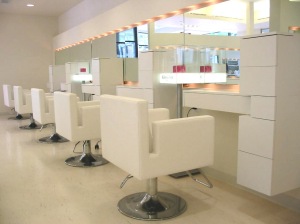Educate yourself on the basics of salon lighting for your hair styling and color area. Here is what you need to know when working with a designer or contractor for an effective lighting design.
Salon lighting should flatter the complexion and compliment the interior. Bulbs come in a variety of temperatures ranging from very warm to cool. A warm temperature bulb (3,200 to 3,500 Kelvin) is the most flattering on the complexion and compliments most salon interiors. Cool temperatures (4,800 Kelvin) can equate to daylight (a sunny afternoon) and is typically not the most flattering temperature (think about being out in broad daylight and how your skin looks in the sun). Daylight/cool temperature bulbs will grey-out warm interiors as well as wash-out guests.
Salon lighting should accurately render color. Have you ever heard stories about guests receiving hair color and make-up applications in the salon only to walk outside and the color appears different? The simple solution is to utilize bulbs in the space that accurately render color. How well a bulb accurately renders color is determined by the bulb’s Color Rendering Index which represents the quality of light and its faithfulness to render colors. Be sure to request bulbs that have a Color Rendering Index (CRI) of 80 or higher.
Salon lighting should be positioned to eliminate shadows. How a guest looks in the salon chair is crucial in the salon environment. If a guest feels good about their appearance, it reinforces a positive experience for repeat business and increased revenues. The easiest way to help eliminate shadows on the face is to position wall lighting on either side of the mirror to directly light the complexion. This too should be a flattering temperature bulb (3,200 to 3,500 Kelvin). Spotty lighting above, such as track fixtures, will also create shadows. In this type of application, wall lighting on the face is even more important.
Invest in energy-efficient bulbs for long term savings. Both Florescent and Light Emitting Diode (LED) bulbs have revolutionized energy efficient lighting. When possible, request salon light fixtures that support these types of lamps. With a wide variety of color temperatures and high Color Rendering Index options, these bulbs are ideal for the salon environment especially for general illumination. Although these lamps are typically higher in cost to purchase, the investment is worth it as these lamps have long life, use less energy, save on maintenance and replacement costs and provide long term savings.
Salon work station. Your salon station lighting comes from two places: the front (wall/sconce lighting) and overhead. The wall lighting is for direct illumination on the face to flatter the complexion and face. The overhead fixtures provide your general overall lighting to perform tasks as well as light the space. If the overhead lighting is properly designed, this will provide enough lighting to perform all of the required tasks for hair styling and color application. Separate task lighting is not required if the overhead lighting is properly configured. Proper overhead lighting will vary from space to space depending upon the ceiling height and type as well as how dark or light the space is. Here is where a lighting designer who understands the intricacies of salon lighting come into play.
Add some sparkle. Typical florescent or LED bulbs, while a wonderful source of general lighting, can be flat. To add some sparkle to the hair, place a halogen bulb directly over each styling chair. Halogen bulbs are flattering with a high color rendering index and are typically used to showcase jewelry and expensive products. Why not provide your guests with this same luxury? Over-use of halogen bulbs or using halogen bulbs as your main source of lighting will cause shadowing. In addition, the life of halogen bulbs is much shorter than florescent or LED lamps.
The best lighting for your salon combines a variety of lighting to suit its particular purpose. While you don’t have to be an expert here, the idea is to be able to effectively communicate the basics so that you can explore all your lighting options to fit your budget and assure a successful result.
More on Salon Design: Click Here

September 2, 2011 at 3:03 pm
salon furniture…
[…]Salon Lighting 101 « Spa Style's Blog[…]…
February 2, 2012 at 2:13 pm
Very helpful in our research for a salon re-design – Thank you!
August 29, 2012 at 10:44 pm
i have vanity lights on each side of my mirror at my station that use round bulbs. i need to know what bulbs to buy so it is not to hot or bright but still flattering to my colors and face of client. they are the vanity light strips u see in bathrooms and there are 9 bulbs.